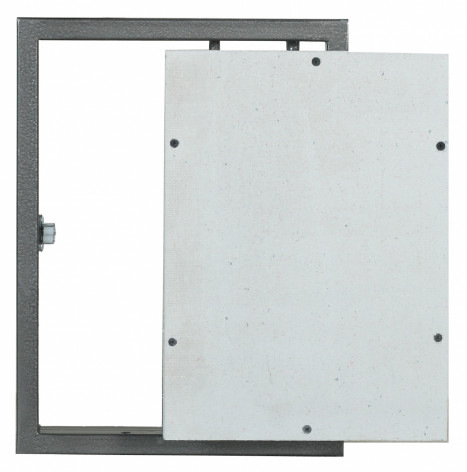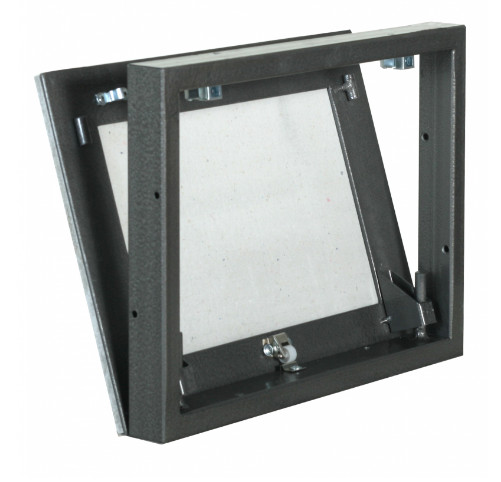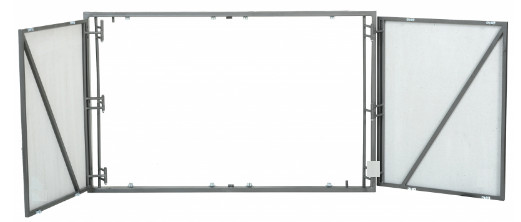Hatches under tiles overview
The tile inspection hatch is a popular model among inspection hatches. It is behind the ceramic tiles that various technical communications are concentrated. First of all, these are taps, filters, water meters and much more that can spoil the appearance of the interior design. Therefore, an invisible hatch under tiles is an excellent option for hiding various components. When tiling a plumbing unit, the hatch under the tile is 100% invisible; it is difficult to find it against the background of the wall if you do not know its location. In the modern world, tile hatches are becoming more and more popular; they are often used by interior designers and tilers.
Types of hatches
Push hatch
The most popular model due to its convenience and ease of opening. The hidden hatch under the tile opens just by pressing its door, after which the push locks are activated, then the door pops out of the opening frontally, without catching the edges of the adjacent tile. Then, due to the two-link curtains, the hatch door moves to the side and then swings open like a regular door. Closing the door proceeds in the reverse order, and when closing it is enough to press the door and with the help of locks the door is fixed in the opening in its place.

Hinged hatch
Or second name hatch for tiles with a suction cup, an equally popular model of hatches which, unlike push hatches, opens using a silicone suction cup that is glued to the plate on the hatch door and pulls it open to open the door. The opening sequence in the future is similar to pressure hatches. Another difference between a swing hatch and a push hatch is its lower price.

Folding hatch
The simplest design of inspection hatches. The main purpose of this hatch is access to inspect hard-to-reach places where there is an obstacle opposite the hatch that prevents the hatch door from opening. The secret hatch under the tiles opens either by pressing or using a silicone suction cup. Afterwards, the hatch is tilted at an angle until it stops, which prevent the lid from falling, after which the lid is removed from the opening upward and towards itself.

Sliding hatch
Another model that is used for places where access is limited or there are obstacles opposite the opening. The sliding sunroof is also divided into 2 types: push-button sunroof and suction-cup sunroof. The hidden hatch under the tile opens towards itself, from the front, after which the door under the tile moves parallel to the wall to the side, thereby opening access for inspection.

Double-door hatch
These are large horizontal hatches, produced for openings more than 60 centimeters wide. The two-door model sanitary hatch for tiles is made of one frame and two doors, each of which can differ in width.

A floor hatch under tiles is also becoming more and more popular in interior decoration, due to the fact that the surface of the lid can be covered with ceramic tiles and can be walked on, a basement hatch under tiles saves room space.
The sizes of hatches for tiles come in a variety of sizes. Basically these are standard sizes that correspond to the sizes of ceramic tiles. Let’s say you have a tile measuring 60 by 30 centimeters, then a hatch for a 60 by 30 tile is ideal for you, or suppose you need an inspection window for 2 tiles each 60 in width and 30 centimeters in height, then a 60 by 60 hatch is suitable for you. In the design of the hatch, its size corresponds to the size of the hatch frame, and the door for the tiles is slightly smaller than the frame. This is specifically to make it easier for the tiler to adjust the tiles to the seams; when they protrude beyond the door, they can be moved to the sides.
People often search on the Internet for: hatches for tiles, as well as hatches for tiles, price, or buy hatches for tiles, our bathroom hatches are the best in terms of price and quality.
Bathroom hatch under tiles or toilet hatch under tiles is the most common use of hatches under tiles. Bathroom hatch under tiles is also a popular use of a hatch, since it is under the bathtub that siphons and assemblies are located that often need inspection. A hatch under tiles for inspection is often used in walls for access to the shaft where meters and taps are located, as well as a hatch under tiles 60 by 100 centimeters or a hatch 60 by 120, or more simply put, a hatch under a boiler – used to hide the boiler behind a false wall and for access to him.
The secret hatch under the tiles is very easy to use. Installing hatches under tiles (see the article “How to install an inspection hatch”) is not difficult for any craftsman, and will take no more than an hour of time. For this purpose, the hatch design provides special holes with a diameter of 6 millimeters with recesses for dowel heads or self-tapping screws.
Inspection hatches for tiles of our design are guaranteed to be reliable. The design of the most popular hatch of the push-type model consists of a welded frame made of a 40 by 20 profile pipe with a wall thickness of 2 millimeters and a welded door also made of a 15 by 15 profile pipe with a wall thickness of 2 millimeters. The tile door and the hatch frame are connected by welded two-piece curtains. Thanks to the special features of the curtains, the hatch door opens from the front and does not chip off the edges of the tiles. European-made push locks have 20,000 cycles of guaranteed operation. The locks also have anti-knock holders, which prevent the door from jamming even if the lock breaks. All metal elements of the hatch are painted with anti-corrosion hammer enamel. A gypsum-fiber moisture-resistant tile (gvlv) is screwed to the hatch door, which has increased strength and moisture resistance.
Table of sizes and main parameters of standard push hatches:
| Hatch dimensions (frame) (WxH mm.) | Door dimensions (WxH mm.) | Door load (kg) | Complete hatch weight (kg) |
|---|---|---|---|
| 200x300 | 152x245 | 9 | 2.1 |
| 200x400 | 152x345 | 11 | 2.3 |
| 200x500 | 152x445 | 12 | 2.7 |
| 300x200 | 252x145 | 9 | 2.1 |
| 300x300 | 252x245 | 13 | 2.5 |
| 300x400 | 252x345 | 14 | 3.2 |
| 300x500 | 252x445 | 16 | 3.9 |
| 300x600 | 252x545 | 18 | 4.6 |
| 400x300 | 352x245 | 14 | 3.2 |
| 400x400 | 352x345 | 16 | 3.6 |
| 400x500 | 352x445 | 18 | 4.3 |
| 400x600 | 352x545 | 20 | 5.0 |
| 400x900 | 352x845 | 27 | 10.0 |
| 500x300 | 452x245 | 16 | 3.9 |
| 500x400 | 452x345 | 18 | 4.3 |
| 500x500 | 452x445 | 20 | 6.5 |
| 500x600 | 452x545 | 23 | 7.7 |
| 500x800 | 452x745 | 27 | 10.0 |
| 600x300 | 552x245 | 18 | 4.6 |
| 600x400 | 552x345 | 20 | 5.0 |
| 600x500 | 562x445 | 24 | 8.8 |
| 600x600 | 552x545 | 30 | 12.7 |
| 600x1000 | 552x945 | 32 | 14.0 |
